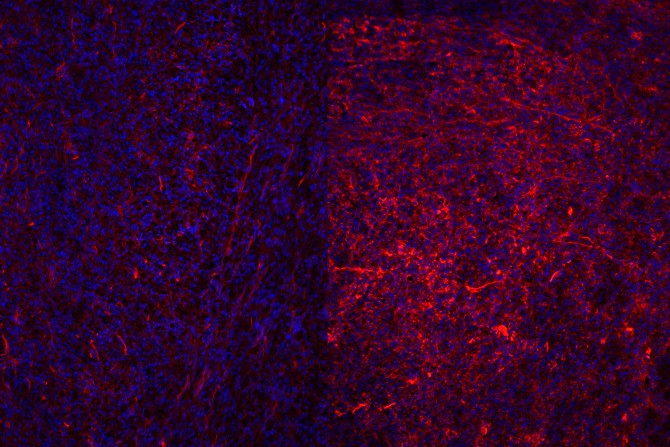Cellular changes that appear during melanoma and lead to treatment resistance can be reversed with drugs - potentially opening the door to new or more effective treatments for the deadly disease, according to new Cornell research.
The extracellular matrix (ECM), a supportive scaffold that surrounds every cell in the body, often becomes denser during cancer treatment. In the study, published Aug. 22 in Advanced Science, researchers from the College of Veterinary Medicine (CVM) showed both how that thickening slows treatment and how to loosen it.
"Melanoma patients usually respond very well to targeted therapy at first, but most eventually relapse as their tumors become resistant to treatment," said Andrew White, associate professor in the Department of Biomedical Science (CVM) and senior author of the study. "We wanted to understand what causes this resistance."
In microscope images of the extracellular matrix and cells, cells are stained in blue and collagen in red. Regressing tumors on the left are surround by less dense collagen compared to resistant ones (right) with dense collagen.
The ECM caught the team's attention because researchers noticed striking changes in collagen, the matrix's main structural protein, during treatment: The ECM becomes unusually dense and overproduced. "What we wanted to know is whether the changes in the ECM were just a side effect of therapy, or if they actually contributed to drug resistance," said Dr. Chia-Hsin Hsu, doctoral student and first author of the study.
The team made two discoveries. First, they explained why even the most powerful targeted therapeutics can fail: They showed that the thickened matrix acts like a physical barrier, preventing cytotoxic T cells, the immune cells that directly kill cancer, from reaching the tumor.
"It changes the way we think about cancer treatment, from focusing only on the cancer cells themselves to understanding and treating the entire tissue environment around them," Hsu said.
Second, they found that using drugs that reduced or loosened this matrix allowed T cells to re-enter the tumor and attack the tumor again.
"It was thrilling to see how changing the extracellular matrix could completely reshape the immune landscape of a tumor," Hsu said. "Under the microscope, we could literally see cytotoxic T cells spreading more evenly once the ECM was reduced. It felt like uncovering a hidden mechanism that had been holding back the immune system from doing its job."
According to the researchers, the discovery could lead to new treatments, pairing existing targeted drugs or immunotherapies with agents that modify the extracellular matrix. Some of these ECM-modifying drugs already exist and are being tested for tissue scarring. Repurposing or fine-tuning them for cancer could help prevent relapses or make existing treatments more effective.
The team is now investigating whether ECM molecules other than collagen affect therapy resistance, and if targeting these molecules could reshape the tumor microenvironment more broadly and further help overcome resistance to therapy.
"Therapy doesn't happen in isolation. It takes place within the constantly changing ecosystem of the tumor microenvironment, and the extracellular matrix is a vital part of that ecosystem," Hsu said. "Our study reminds us that curing cancer isn't just about killing cancer cells. It's also about restoring the body's own environment so that the immune system can fight back effectively."
Elodie Smith is a writer for the College of Veterinary Medicine.







